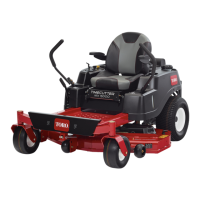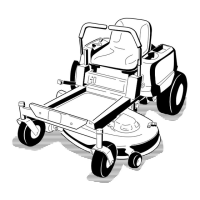1. Cutting edge
2. Curved area
2 \
C___ _'''_ 3
Figure 25
3. Wear/slot forming
m-151
A blade that is bent or damaged could break apart
and could seriously injure or kill you or
bystanders.
* Always replace bent or damaged blade with a
new blade.
* Never file or create sharp notches in the edges
or surfaces of blade.
Checking for Bent Blades
1. Rotate the blades until the ends face forward and
backward (Fig. 26). Measure from a level surface to the
cutting edge, position A, of the blades (Fig. 26). Note
this dimension.
/-- "...............
Y i .
A
m-6427
\\
\\
)
i
I
\,\ i
Figure 26
2.
3.
Rotate the opposite ends of the blades forward.
Measure from a level surface to the cutting edge of the
blades at the same position as in step 1. The difference
between the dimensions obtained in steps 1 and 2 nmst
not exceed 1/8 inch (3 mln). If this dimension exceeds
1/8 inch (3 nml), the blade is bent and nmst be replaced.
Refer to Removing the Blades, and Installing the Blades
on page 25.
Removing the Blades
The blades must be replaced if a solid object is hit, if the
blade is out of balance, or the blade is bent. To ensure
optimum performance and continued safety conformance of
the machine, use genuine Toro replacement blades.
Replacement blades made by other manuPacturers may
result in non-conformance with safety standards.
Hold the blade end using a rag or thickly-padded glove.
Remove the blade bolt, curved washer, blade stiffener, and
blade from the spindle shaft (Fig. 27).
4 ......
Figure 27
1. Sail area of blade 4. Blade bolt
2. Blade 5. Blade stiffener
3. Curvedwasher
m-6430
Sharpening the Blades
1.
Use a file to sharpen the cutting edge at both ends of the
blade (Fig. 28). Maintain the original angle. The blade
retains its balance if the same amount of material is
removed from both cutting edges.
24

